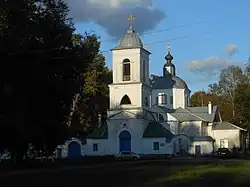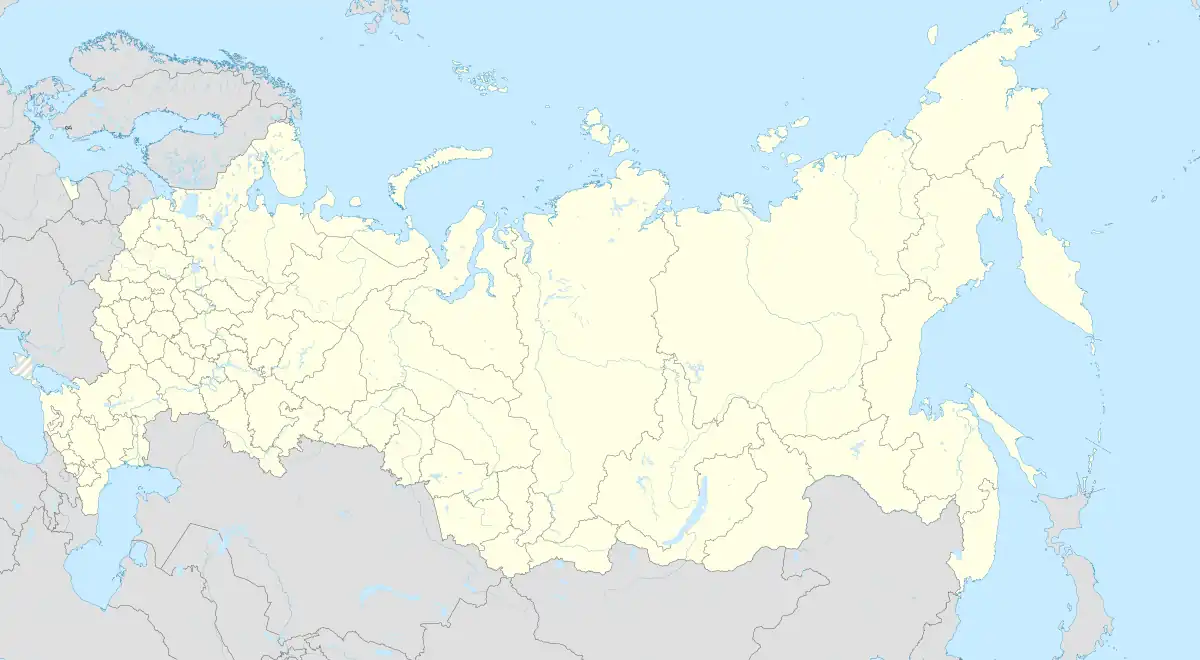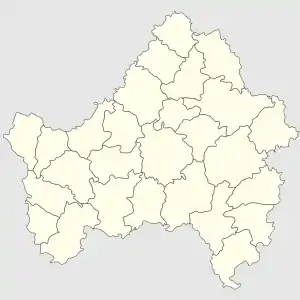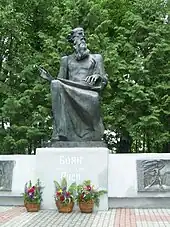Trubchevsk
Трубчевск | |
|---|---|
 Church of the Presentation of Jesus at the Temple | |
_(1781).png.webp) Coat of arms | |
Location of Trubchevsk | |
 Trubchevsk Location of Trubchevsk  Trubchevsk Trubchevsk (Bryansk Oblast) | |
| Coordinates: 52°34′N 33°46′E / 52.567°N 33.767°E | |
| Country | Russia |
| Federal subject | Bryansk Oblast[1] |
| Administrative district | Trubchevsky District[2] |
| Urban Administrative Okrug | Trubchevsky[2] |
| First mentioned | See text |
| Elevation | 150 m (490 ft) |
| Population | |
| • Total | 15,014 |
| • Estimate (2018)[4] | 14,001 (−6.7%) |
| • Capital of | Trubchevsky District,[1] Trubchevsky Urban Administrative Okrug[2] |
| • Municipal district | Trubchevsky Municipal District[5] |
| • Urban settlement | Trubchevskoye Urban Settlement[5] |
| • Capital of | Trubchevsky Municipal District,[5] Trubchevskoye Urban Settlement[5] |
| Time zone | UTC+3 (MSK |
| Postal code(s)[7] | 242220 |
| OKTMO ID | 15656101001 |
Trubchevsk (Russian: Трубче́вск, Polish: Trubczewsk) is a town and the administrative center of Trubchevsky District in Bryansk Oblast, Russia, located about 95 kilometers (59 mi) south of the city of Bryansk, the administrative center of the oblast. Population: 13,287 (2021 Census);[8] 15,014 (2010 Census);[3] 16,342 (2002 Census);[9] 16,301 (1989 Census).[10]
History
An old Severian town, Trubchevsk was first mentioned as Trubetsk in East Slavic manuscripts describing the events of 1164 and 1183, although the locally 975 is regarded as the year of its foundation. At that early period, it was variously called Trubech (Трубечь), Trubetsk (Трубецк), Trubchesk (Трубческ), or Trubezhsk (Трубежск).
The town is referred to in the great Old Russian poem, The Tale of Igor's Campaign. This poem calls for the princes of the various Slavic lands to join forces in resisting the invasions of the nomadic Cuman people. The poem also glorified the courage of the army of Vsevolod Svyatoslavich, the ruler of Kursk and Trubchevsk.
Originally a minor center of Severia, Trubchevsk had its own princes sporadically throughout the Middle Ages, in 1164–1196, 1202–1211, 1212–1240, 1378–1399, and finally in 1462–1503. From 1379, it was part of Lithuania.[11] As of 1402, it was held by Duke Švitrigaila.[11] In 1503, the town passed from Lithuania (by then within the Polish–Lithuanian union) to Muscovy.[11] The last dynasty eventually settled in Moscow, where they became known as Princes Trubetskoy. In 1609, it was recaptured by the Polish–Lithuanian Commonwealth, within which it was administratively part of the Smolensk Voivodeship. In Polish it was known as Trubczewsk and Trubeck, and its Latinized name was Trubeckum.[11] In 1644, it passed to Russia.[11] In 1663 and 1667 it was besieged by the Poles and Tatars.[11]
In 1873, the town had a population of 5,451.[11] In the late 19th century, its inhabitants were mostly employed in flax processing and spinning, crafts, shipbuilding and trade.[11] Three annual fairs and two weekly markets were held.[11]
During World War II, Trubchevsk was occupied by the German Army from October 9, 1941 to September 18, 1943. Prior to the war, about 137 Jews lived in Trubchevsk. Most of the Jews were craftsmen, including cobblers and carpenters. By the time of the German occupation, more than half of the Jews fled or evacuated. The Jews from the Trubchevsk district were gathered in a Klub for 3 days and shot afterwards at the edge of the village. Their bodies were burnt. In total, according to the Soviet archives, 751 Soviet citizens perished due to bad treatment or as a result of shooting in the entire Trubchevsk district. Aside from Jews, mentally ill children and adults were exterminated as well.[12] The Germans also operated a Nazi prison in the town.[13]
Administrative and municipal status
Within the framework of administrative divisions, Trubchevsk serves as the administrative center of Trubchevsky District.[1] As an administrative division, it is incorporated within Trubchevsky District as Trubchevsky Urban Administrative Okrug.[2] As a municipal division, Trubchevsky Urban Administrative Okrug is incorporated within Trubchevsky Municipal District as Trubchevskoye Urban Settlement.[5]
Architecture
There are very few notable buildings in the town. The main landmark is the 19th-century Trinity Cathedral, which incorporates some parts from its 16th-century predecessor.
References
Notes
- 1 2 3 4 Law #13-Z
- 1 2 3 4 Law #69-Z
- 1 2 Russian Federal State Statistics Service (2011). Всероссийская перепись населения 2010 года. Том 1 [2010 All-Russian Population Census, vol. 1]. Всероссийская перепись населения 2010 года [2010 All-Russia Population Census] (in Russian). Federal State Statistics Service.
- ↑ "26. Численность постоянного населения Российской Федерации по муниципальным образованиям на 1 января 2018 года". Federal State Statistics Service. Retrieved January 23, 2019.
- 1 2 3 4 5 Law #3-Z
- ↑ "Об исчислении времени". Официальный интернет-портал правовой информации (in Russian). June 3, 2011. Retrieved January 19, 2019.
- ↑ Почта России. Информационно-вычислительный центр ОАСУ РПО. (Russian Post). Поиск объектов почтовой связи (Postal Objects Search) (in Russian)
- ↑ Russian Federal State Statistics Service. Всероссийская перепись населения 2020 года. Том 1 [2020 All-Russian Population Census, vol. 1] (XLS) (in Russian). Federal State Statistics Service.
- ↑ Russian Federal State Statistics Service (May 21, 2004). Численность населения России, субъектов Российской Федерации в составе федеральных округов, районов, городских поселений, сельских населённых пунктов – районных центров и сельских населённых пунктов с населением 3 тысячи и более человек [Population of Russia, Its Federal Districts, Federal Subjects, Districts, Urban Localities, Rural Localities—Administrative Centers, and Rural Localities with Population of Over 3,000] (XLS). Всероссийская перепись населения 2002 года [All-Russia Population Census of 2002] (in Russian).
- ↑ Всесоюзная перепись населения 1989 г. Численность наличного населения союзных и автономных республик, автономных областей и округов, краёв, областей, районов, городских поселений и сёл-райцентров [All Union Population Census of 1989: Present Population of Union and Autonomous Republics, Autonomous Oblasts and Okrugs, Krais, Oblasts, Districts, Urban Settlements, and Villages Serving as District Administrative Centers]. Всесоюзная перепись населения 1989 года [All-Union Population Census of 1989] (in Russian). Институт демографии Национального исследовательского университета: Высшая школа экономики [Institute of Demography at the National Research University: Higher School of Economics]. 1989 – via Demoscope Weekly.
- 1 2 3 4 5 6 7 8 9 Słownik geograficzny Królestwa Polskiego i innych krajów słowiańskich, Tom XII (in Polish). Warszawa. 1892. p. 514.
{{cite book}}: CS1 maint: location missing publisher (link) - ↑ "Yahad - in Unum".
- ↑ "NS-Gefängnis Trubcevsk". Bundesarchiv.de (in German). Retrieved October 29, 2022.
Sources
- Брянская областная Дума. Закон №13-З от 5 июня 1997 г. «Об административно-территориальном устройстве Брянской области», в ред. Закона №4-З от 5 февраля 2014 г. «О внесении изменений в отдельные законодательные акты Брянской области». Опубликован: "Брянский рабочий", №119, 24 июня 1997 г. (Bryansk Oblast Duma. Law #13-Z of June 5, 1997 On the Administrative-Territorial Structure of Bryansk Oblast, as amended by the Law #4-Z of February 5, 2014 On Amending Various Legislative Acts of Bryansk Oblast. ).
- Брянская областная Дума. Закон №69-З от 2 ноября 2012 г. «Об образовании городских административных округов, поселковых административных округов, сельских административных округов, установлении границ, наименований и административных центров административных округов в Брянской области». Вступил в силу 1 января 2013 г. Опубликован: Информационный бюллетень "Официальная Брянщина", №16, 6 ноября 2012 г.. (Bryansk Oblast Duma. Law #69-Z of November 2, 2002 On the Establishment of Urban Administrative Okrugs, Settlement Administrative Okrugs, Rural Administrative Okrugs, on Establishing Borders, Names, and Administrative Centers of the Administrative Okrugs of Bryansk Oblast. Effective as of January 1, 2013.).
- Брянская областная Дума. Закон №3-З от 9 марта 2005 г. «О наделении муниципальных образований статусом статусом городского округа, муниципального района, городского поселения, сельского поселения и установлении границ муниципальных образований в Брянской области», в ред. Закона №75-З от 28 сентября 2015 г. «Об изменении статуса населённого пункта посёлок Красный Ятвиж Клетнянского района Брянской области». Вступил в силу через 10 дней после официального опубликования. Опубликован: "Брянская неделя", №13, 8 апреля 2005 г. (Bryansk Oblast Duma. Law #3-Z of March 9, 2005 On Granting the Municipal Formations the Status of Urban Okrug, Municipal District, Urban Settlement, Rural Settlement and on Establishing the Borders of the Municipal Formations of Bryansk Oblast, as amended by the Law #75-Z of September 28, 2015 On Changing the Status of the Inhabited Locality the Settlement of Krasny Yatvizh in Kletnyansky District of Bryansk Oblast. Effective as of the day which is 10 days after the official publication.).
External links
- Official website of the Council of People's Deputies of Trubchevsk (in Russian)
- Photographs of Trubchevsk (in Russian)
